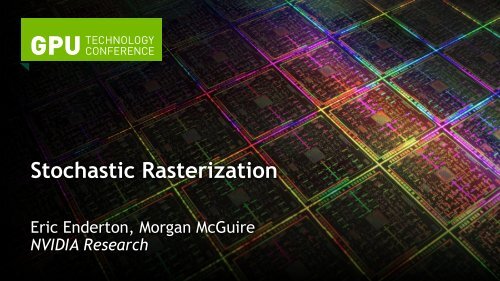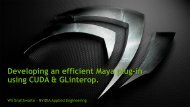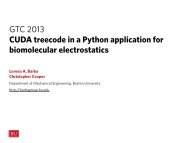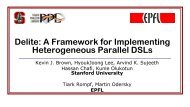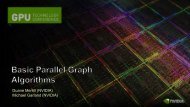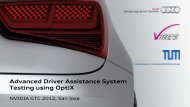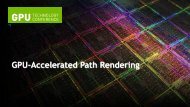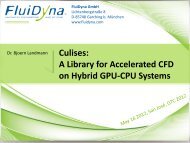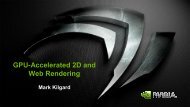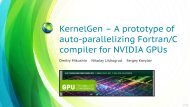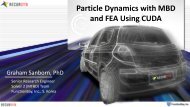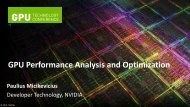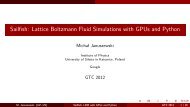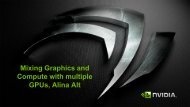Stochastic Rasterization - GPU Technology Conference 2012
Stochastic Rasterization - GPU Technology Conference 2012
Stochastic Rasterization - GPU Technology Conference 2012
You also want an ePaper? Increase the reach of your titles
YUMPU automatically turns print PDFs into web optimized ePapers that Google loves.
<strong>Stochastic</strong> <strong>Rasterization</strong>Eric Enderton, Morgan McGuireNVIDIA Research
9 fps on Geforce GT 280
60 fps on Geforce GT 280
Distribution Ray Tracing• Spatial AA— pixel (x,y)• Motion blur— time (t)• Defocus blur / DOF— lens (u,v)• Monte Carlo sampling• Same rays sample all dimensions at once
<strong>Stochastic</strong> <strong>Rasterization</strong>• The same thing, but leveraging hardware rasterization• No rays• Interactive speeds• Transparency
MSAA• Multi-Sample Anti-Aliasing— Hardware supports up to 8 samples per pixel— Spatial anti-aliasing only (triangle edges)— Not stochastic• Shade once per pixel, not once per sample— Actually once / fragment— A major performance criterion for us
MSAA(Kayvon Fatahalian, “Beyond Programmable Shading” course, SIGGRAPH 2010)
Familiar stuff, sub-pixel
Motion Blur
Conventional:no blurfor each x, y sample and triangle Q:t*, u*, v* = t, u, vz,a,b = intersect(Q, x, y, t*, u*, v*)if z < depth[x, y]:color[x, y] = shade(a, b, t s , u s , v s )depth[x, y] = zreturn colorAccumulation:for each t, u, v sample:temp += conventional(t, u, v)++Nreturn temp / Nghosts<strong>Stochastic</strong>:noisy1 sample per pixel 256x MSAA…or 16x + animation?
(2+1)D2D <strong>Rasterization</strong>Geometry Shader2D RasterizerPixel Shader1. Bound the triangle’s screen-space extent due to its shape (xy)2. Iterate over the samples in that bound3. Perform some xy inside-outside test per sample4. Shade the samples that passtand motion (t)t = 0 t = 1
Extending an Existing RendererC++ HostVertex ShaderGeometry ShaderPixel Shader
Extending an Existing RendererC++ HostVertex ShaderGeometry ShaderPixel Shader+ velocity attribute+ camera velocity uniform+ duplicate transformcode for prev. vtx+ convex hull ofprev & current+ set MSAA mask fromray-triangle testsShading code is unmodified!(source code at nvidia.com/research)
Geometry Shaderz = 0z = z near-z +z“Normal”: All z < 0: Projected HullAll z > z near : Cull“z=0 crossing”: z min < z near and z max > 0: Clip and Box
Extreme Example of z = 0 Case16
Extreme Example of z = 0 Case17
Extreme Example of z = 0 Case18
Correct result for a moving camera19
Integration with MSAA• Perform ray-triangle test per sample• Override the pixel’s coverage mask• Shade at most once per pixel• Use ray differentials (like screen-space derivatives) to setanisotropic MIP-map levels
Pixel Shader// Sample stochastic visibilityfor (int i = 0; i < MSAA_SAMPLES; ++i) {getRay(origin, dir, i, gl_FragCoord.xy);if (intersectRay(origin, dir, time[i], u, v)) {gl_SampleMask[0] |= (1
Multisample Rate: 1x22
Multisample Rate: 4x23
Multisample Rate: 8x24
Multisample Rate: 16x25
Multisample Rate: 64x26
Multisample Rate: 256x27
AABBConvex Hull29Sample Test EfficiencyScene
Depth of Field
New Bounding Geometry
Multisample Rate: 1x32
Multisample Rate: 4x33
Multisample Rate: 8x34
Multisample Rate: 16x35
Multisample Rate: 64x36
<strong>Stochastic</strong> Transparency
Transparency• hair• foliage• particles• windows• shadows thereof
Order dependent
But sorting is painful• Sort primitives— Fails for overlaps— Disrupts engine code• Sort per pixel— A-Buffer— Unbounded memory• Want: Order Independent Transparency (OIT)
cf. [Fuchs et al 1995]
Correct on average• … if the masks are uncorrelated.• Uses the z buffer to be order independent.
<strong>Stochastic</strong> TransparencyScreen-door + multi-sampling + random masks.• Correct on average• All cases unified in a single algorithm— Foliage, Smoke, Hair, Glass, mixtures• One order-independent pass over the geometry• Small fixed space (one MSAA frame buffer)• But, noise
MSAA helps• Get S = 8*P samples per pixel, in P passes• Pixel Shader sets 8-bit mask as pseudo-random function ofalpha, x, y, prim ID.• Spatial AA with the same samples• Shading rate stays 1/fragment
(Reference)
8 spp
16 spp
32 spp
64 spp
512 spp
<strong>Stochastic</strong> Shadow Map• Run <strong>Stochastic</strong> Transparency, rendering only z• Optional: Render with MSAA hardware Each map pixel contains S depth values• Models the deep shadow function vis(z) =How much light gets from camera to depth z
<strong>Stochastic</strong> Shadow Map10z
<strong>Stochastic</strong> Shadow Map• Every pixel looks the same— S z-values— z’s not sorted• Look-up is just PCF— S comparisons per shadow-map pixel• Color, better reconstruction filter in [CSSM paper]
Colored <strong>Stochastic</strong> Shadow Maps
Depth-based <strong>Stochastic</strong> Transparency• With an extra pass, you can do a lot better• Shadow map from camera POV• Final color is (parallel) sum:— C = sigma vis(z) a_i c_i— vis(z) estimated using shadow map• Very convenient on <strong>GPU</strong>:— For sum, compare fragment z to shadow map z’s— MSAA z-buffer comparison can do S compares at once
<strong>Stochastic</strong> Transparency• Randomized, sub-pixel screen-door transparency• Distribute samples over an invisible dimension of Swisscheese• Correct on average but noisy• Streaming, fixed space, parallel, MSAA• Turns transparent stuff into opaque stuff• … Which can then be handled by opaque-only algorithms(including stochastic MB + DOF)
Advanced Topics• Stratified sampling• Sample test efficiency• Reconstruction
Bibliography• “Hardware-Accelerated <strong>Stochastic</strong> <strong>Rasterization</strong> on Conventional <strong>GPU</strong>Architectures,” McGuire, Enderton, Shirley & Luebke, HPG 2010• “<strong>Stochastic</strong> Transparency,” Enderton, Sintorn, Shirley & Luebke, TVCG 2011• “Colored <strong>Stochastic</strong> Shadow Maps,” McGuire & Enderton, I3D 2011• “Stratified Sampling for <strong>Stochastic</strong> Transparency,” Laine & Karras, EGSR 2011• “Clipless Dual-Space Bounds for Faster <strong>Stochastic</strong> <strong>Rasterization</strong>,” Laine, Aila,Karras & Lehtinen, Siggraph 2011• “A Local Image Reconstruction Algorithm for <strong>Stochastic</strong> Rendering,” Shirley,Aila, Cohen, Enderton, Laine, Luebke & McGuire, I3D 2011• “Temporal Light Field Reconstruction for Rendering Distribution Effects,”Lehtinen, Aila, Chen, Laine & Durand, SIGGRAPH 2011
Backup
Deep Shadow Maps“Deep Shadow Maps”, Lokovic and Leach (Siggraph 2000)• How much light gets from camera to depth z == How much light gets from depth z to camera
Transparency without sortingPorter-Duff:Rearrange to find the contribution of each fragment:using our friendThe sum is order independent, given vis(z).Approximate vis(z) approximate sum.


